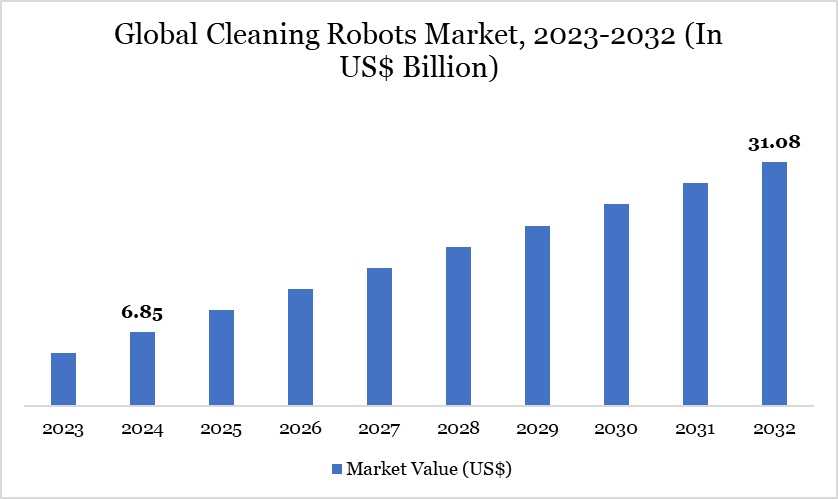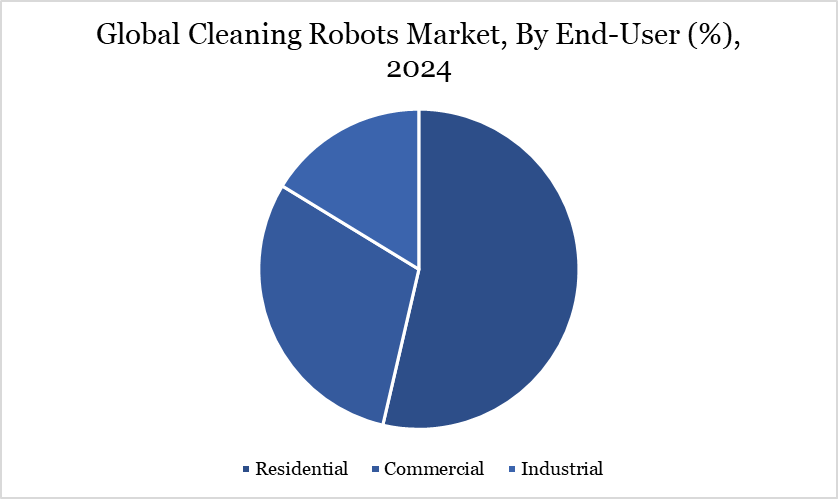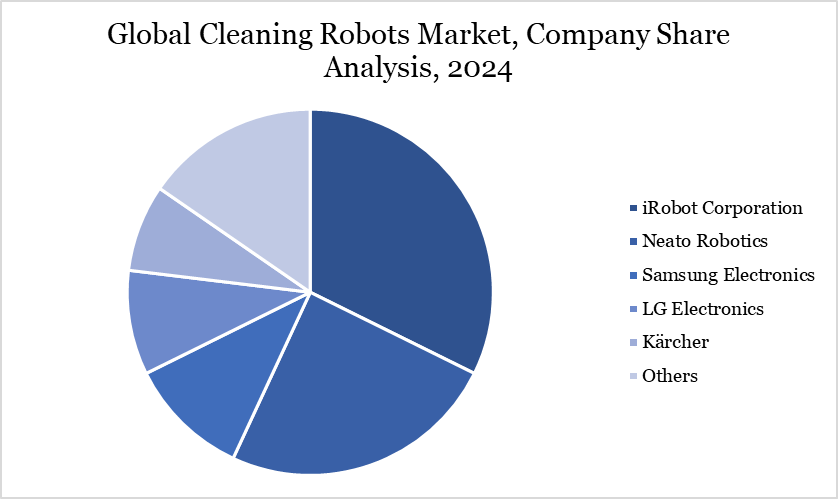Overview
Global cleaning robots Market reached US$ 6.85 billion in 2024 and is expected to reach US$ 31.08 billion by 2032, growing with a CAGR of 20.81% during the forecast period 2025-2032.
The cleaning robot market is quickly expanding as households and companies embrace automation to provide more effective cleaning solutions. Robots with powerful sensors, artificial intelligence and mapping skills can vacuum, clean and scrub floors with little human intervention. The demand for time-saving and consistent cleaning solutions has grown across multiple industries, including residential, commercial and industrial.

Furthermore, rising labor costs and shifting consumer behaviors are driving the deployment of these robots, particularly in smart homes and business settings. Technological advancements like as better object identification and self-navigation are moving the sector forward. According to the International Federation of Robotics, in 2023, the industrial robot industry is expected to grow by 7% to over 590,000 units worldwide, with cleaning robots accounting for a significant share of this expansion.
Cleaning Robots Market Trend
The market's main trend is rapid technological innovation, which includes advances in artificial intelligence, machine learning and sensor technology. The breakthroughs allow robots to better navigate places and perform tasks with higher accuracy. The increased use of smart home devices is a crucial factor, especially as more customers seek connected home ecosystems that provide convenience.
Furthermore, increased investments in robotics research and development are driving this trend. The International Federation of Robotics has set aside $8.2 billion for unmanned systems research in fiscal year 2022, with an emphasis on enhancing smart and autonomous system capabilities. Cleaning robots are frequently used in the business sector, particularly in healthcare institutions, hotels and airports where high cleanliness standards are critical for safety and client happiness.
Market Scope
| Metrics | Details |
| By Type | Personal Cleaning Robots, Professional Cleaning Robots |
| By Product | Floor Cleaning Robots, Lawn Cleaning Robots, Pool Cleaning Robots, Window Cleaning Robots, Others |
| By Operation Mode | Self-Driven, Remote Controlled |
| By End-User | Residential, Commercial, Industrial |
| By Sales Channel | Online, Offline |
| By Region | North America, South America, Europe, Asia-Pacific, Middle East and Africa |
| Report Insights Covered | Competitive Landscape Analysis, Company Profile Analysis, Market Size, Share, Growth |
Dynamic
Rising Sustainability and Labor Cost Concerns
The cleaning robot market is benefiting from the increased emphasis on sustainability and the drive to reduce energy usage. The robots are meant to be energy efficient, which is critical as businesses and homes attempt to fulfill global environmental objectives. According to the American Council for an Energy-Efficient Economy, smart technology such as cleaning robots have the potential to reduce domestic energy use by up to 30% by 2030.
Furthermore, the robots' ability to save water and detergent in industrial cleaning applications is gaining popularity. The rising labor costs, particularly in wealthy countries, are encouraging corporations to consider robotic alternatives. According to the Bureau of Labor Statistics, in the US alone, the average hourly wage for cleaning professionals increased by 5.8% from 2022 to 2023, underlining the need for cost-effective automated solutions.
High Costs and Limited Capabilities
High initial costs continue to be a major barrier to the widespread adoption of cleaning robots, particularly in developing regions. Industrial-grade cleaning robots can cost anywhere between US$ 50,000 to US$ 150,000, depending on their functionality and size. Small businesses and residential consumers may find these costs prohibitive, limiting market penetration in price-sensitive areas.
Additionally, some cleaning robots still have limitations in handling complex environments or specific cleaning tasks, such as reaching tight corners or handling hazardous materials. For instance, while navigation technology is advancing, cleaning robots may struggle in highly cluttered environments, reducing their effectiveness in certain settings.
Segment Analysis
The global cleaning robots market is segmented based on type, product, operation mode, end-user, sales channel and region.

Commercial Sector Driving Growth in High-Traffic Areas
The commercial sector, notably in hospitality and healthcare, is driving significant demand for cleaning robots. Facilities with heavy foot traffic, such as airports, malls and hotels, are increasingly using autonomous robots to maintain cleanliness and cut manual labor expenses. In healthcare, the rise of healthcare-acquired infections (HAIs) leads to the rising use of robotic cleaning systems in hospitals.
The World Health Organization (WHO) predicts that 7% of hospitalized patients in industrialized nations and 10% in developing countries have at least one HAI, accelerating the demand for effective, self-cleaning technologies. Furthermore, the business sector has experienced a significant increase in the usage of ultraviolet (UV) cleaning robots, which are intended to disinfect surfaces by killing hazardous germs and viruses. This tendency gained hold during the COVID-19 epidemic and continues to drive commercial innovation.
Geographical Penetration
Rising Demand for Automation in Asia-Pacific
Asia-Pacific dominates the global cleaning robot market, owing to technical improvements and growing desire for automation. China, Japan and South Korea are in the forefront of integrating robotic cleaning technologies into residential and commercial settings. The spike in smart city developments and greater usage of smart home systems in these countries is driving up demand.
As per the International Federation of Robotics (IFR), Asia-Pacific accounts for approximately 70% of global robotics sales, with the cleaning robot market among the fastest growing. Major businesses are also prioritizing the region, with Dyson, a British company specializing in robot cleaners, launching its flagship model, the Dyson 360 Eye, in Japan rather than the UK or the US.
Sustainability Analysis
The cleaning robot market is aligned with global sustainability goals, with an emphasis on the development of energy-efficient and environmentally friendly technologies. Companies are developing cleaning robots that use less electricity, water and detergents, helping to reduce the carbon footprint associated with traditional cleaning procedures.
Governments around the world are encouraging these improvements by offering incentives and tax breaks to manufacturers who embrace green technologies. For example, the European Commission's Green Deal, which seeks to make Europe climate-neutral by 2050, encourages the use of energy-efficient robots in business settings. This includes cleaning robots that comply with high environmental regulations, which reduce overall energy usage and waste.
Competitive Landscape

The major global players in the market include iRobot Corporation, Neato Robotics, Samsung Electronics, LG Electronics, Kärcher, Cleanfix Reinigungssysteme AG, Peppermint, TASKI, Hako GmbH and LionsBot International Pte Ltd.
Key Developments
In April 2024, Xiaomi announced the Robot Vacuum S10, which is designed to increase cleaning efficiency through superior navigation technology and high suction capabilities, making it perfect for maintaining cleanliness in a variety of living environments. With clever mapping and obstacle avoidance functions, this vacuum easily navigates around furniture and obstructions.
In January 2024, Samsung Electronics has revealed plans to launch a new line of powerful artificial intelligence (AI) vacuum cleaners at CES 2024. The Bespoke Jet Bot Combo vacuum and mop robot cleaner aims to improve customer comfort by featuring better AI capabilities and a steam cleaning function, making cleaning more efficient for consumers.
Why Choose DataM?
Data-Driven Insights: Dive into detailed analyses with granular insights such as pricing, market shares and value chain evaluations, enriched by interviews with industry leaders and disruptors.
Post-Purchase Support and Expert Analyst Consultations: As a valued client, gain direct access to our expert analysts for personalized advice and strategic guidance, tailored to your specific needs and challenges.
White Papers and Case Studies: Benefit quarterly from our in-depth studies related to your purchased titles, tailored to refine your operational and marketing strategies for maximum impact.
Annual Updates on Purchased Reports: As an existing customer, enjoy the privilege of annual updates to your reports, ensuring you stay abreast of the latest market insights and technological advancements. Terms and conditions apply.
Specialized Focus on Emerging Markets: DataM differentiates itself by delivering in-depth, specialized insights specifically for emerging markets, rather than offering generalized geographic overviews. This approach equips our clients with a nuanced understanding and actionable intelligence that are essential for navigating and succeeding in high-growth regions.
Value of DataM Reports: Our reports offer specialized insights tailored to the latest trends and specific business inquiries. This personalized approach provides a deeper, strategic perspective, ensuring you receive the precise information necessary to make informed decisions. These insights complement and go beyond what is typically available in generic databases.
Target Audience 2024
Manufacturers/ Buyers
Industry Investors/Investment Bankers
Research Professionals
Emerging Companies


